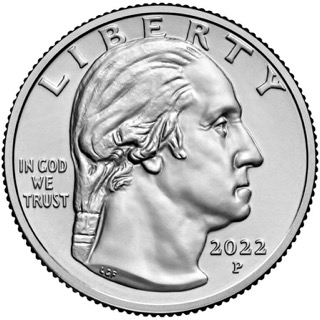
The quarter, short for quarter dollar, is a United States coin worth 25 cents, one-quarter of a dollar. The coin sports the profile of George Washington on its obverse, and after 1998 its reverse design has changed frequently. It has been produced on and off since 1796 and consistently since 1831.
The dollar coin is a United States coin with a face value of one United States dollar. Dollar coins have been minted in the United States in gold, silver, and base metal versions. Dollar coins were first minted in the United States in 1794.
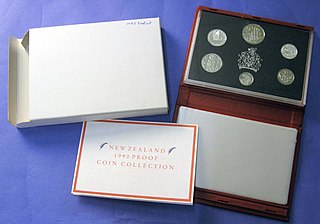
Proof coinage refers to special early samples of a coin issue, historically made for checking the dies and for archival purposes. Nowadays proofs are often struck in greater numbers specially for coin collectors (numismatists). Nearly all countries have issued proof coinage.
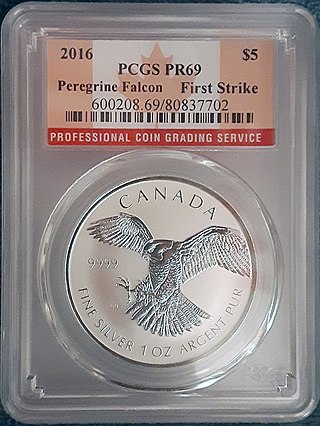
Coin grading is the process of determining the grade or condition of a coin, one of the key factors in determining its collectible value. A coin's grade is generally determined by six criteria: strike, preservation, luster, color, attractiveness, and occasionally the country/state in which it was minted. Several grading systems have been developed. Certification services professionally grade coins for tiered fees.
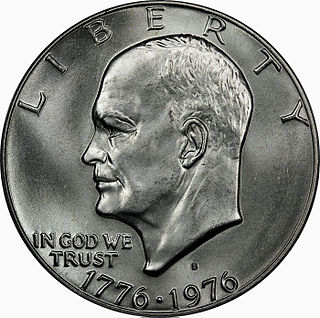
The United States Bicentennial coinage is a set of circulating commemorative coins, consisting of a quarter, half dollar and dollar struck by the United States Mint in 1975 and 1976. Regardless of when struck, each coin bears the double date 1776–1976 on the normal obverses for the Washington quarter, Kennedy half dollar and Eisenhower dollar. No coins dated 1975 of any of the three denominations were minted.

The Eisenhower dollar was a one-dollar coin issued by the United States Mint from 1971 to 1978; it was the first coin of that denomination issued by the Mint since the Peace dollar series ended in 1935. The coin depicts President Dwight D. Eisenhower on the obverse, and a stylized image honoring the 1969 Apollo 11 Moon mission on the reverse. Both sides were designed by Frank Gasparro, with the reverse based on the mission patch designed by astronaut Michael Collins. It is the only large-size U.S. dollar coin whose circulation strikes contained no silver.

The American Silver Eagle is the official silver bullion coin of the United States.

The American Gold Eagle is an official gold bullion coin of the United States. Authorized under the Gold Bullion Coin Act of 1985, it was first released by the United States Mint in 1986. Because the term "eagle" also is the official United States designation for pre-1933 ten dollars gold coins, the weight of the bullion coin is typically used when describing American Gold Eagles to avoid confusion. This is particularly true with the 1/4-oz American Gold Eagle, which has a marked face value of ten dollars.
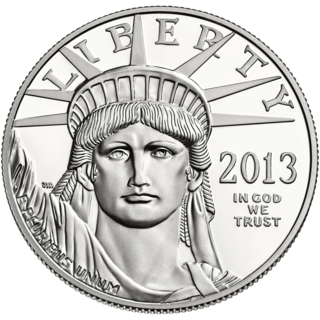
The American Platinum Eagle is the official platinum bullion coin of the United States. In 1995, Director of the United States Mint Philip N. Diehl, American Numismatic Association President David L. Ganz, and Platinum Guild International Executive Director Jacques Luben began the legislative process of creating the Platinum Eagle. After over two years of work, the 99.95% fine platinum coins were released by the United States Mint in 1⁄10, 1⁄4, 1⁄2 and 1 troy oz denominations. In late 2008, the fractional denominations were discontinued, leaving only the one ounce denomination. The Platinum Eagle is authorized by the United States Congress, and is backed by the United States Mint for weight, content, and purity.

The San Francisco Mint is a branch of the United States Mint. Opened in 1854 to serve the gold mines of the California Gold Rush, in twenty years its operations exceeded the capacity of the first building. It moved into a new one in 1874, now known as the Old San Francisco Mint. In 1937 Mint operations moved into a third building, the current one, completed that year.

The West Point Mint is a U.S. Mint production and depository facility erected in 1937 near the U.S. Military Academy in West Point, New York, United States. As of 2019 the mint holds 22% of the United States' gold reserves, or approximately 54,000,000 troy ounces (1,700,000 kg). The mint at West Point is second only to the gold reserves held in secure storage at Fort Knox. Originally, the West Point Mint was called the West Point Bullion Depository. At one point it had the highest concentration of silver of any U.S. mint facility, and for 12 years produced circulating Lincoln cents. It has since minted mostly commemorative coins and stored gold.
This glossary of numismatics is a list of definitions of terms and concepts relevant to numismatics and coin collecting, as well as sub-fields and related disciplines, with concise explanations for the beginner or professional.

The Jefferson nickel has been the five-cent coin struck by the United States Mint since 1938, when it replaced the Buffalo nickel. From 1938 until 2004, the copper-nickel coin's obverse featured a profile depiction of Founding Father and third U.S. President Thomas Jefferson by artist Felix Schlag; the obverse design used in 2005 was also in profile, though by Joe Fitzgerald. Since 2006 Jefferson's portrayal, newly designed by Jamie Franki, faces forward. The coin's reverse is still the Schlag original, although in 2004 and 2005 the piece bore commemorative designs.
The America the Beautiful quarters were a series of fifty-six 25-cent pieces (quarters) issued by the United States Mint, which began in 2010 and lasted until 2021. The obverse (front) of all the coins depicts George Washington in a modified version of the portrait used for the original 1932 Washington quarter. There were five new reverse (back) designs each year, each commemorating a national natural or historic site such as national parks, national historic site, or national forests – one from each state, the federal district, and each territory. The program was authorized by the America's Beautiful National Parks Quarter Dollar Coin Act of 2008 (Pub. L.Tooltip Public Law 110–456 .

The Sheldon Coin Grading Scale is a 70-point coin grading scale used in the numismatic assessment of a coin's quality. The American Numismatic Association based its Official ANA Grading Standards in large part on the Sheldon scale. The scale was created by William Herbert Sheldon.
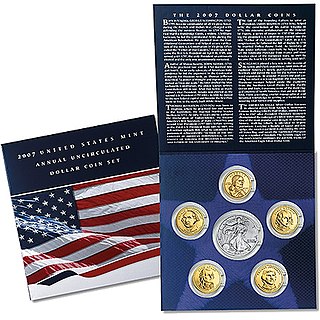
A coin set, or mint set, is a collection of Uncirculated or Proof coins, released by a mint. Such sets are usually released annually and often called a year set. They include sets of all the circulating coins of that year, as well as sets of commemorative coins.

The American Palladium Eagle is the official palladium bullion coin of the United States. Each coin has a face value of $25 and is composed of 99.95% fine palladium, with 1 troy ounce actual palladium weight.

The Apollo 11 50th Anniversary commemorative coins were issued by the United States Mint in 2019 to commemorate the 50th anniversary of the first crewed landing on the Moon by Apollo 11 astronauts Neil Armstrong and Buzz Aldrin. Consisting of a gold half eagle, two different sizes of silver dollars, and a copper-nickel clad half dollar, each of the four was issued in proof condition, with all but the larger silver dollar also issued in uncirculated. The gold coins were struck at the West Point Mint, the silver at the Philadelphia Mint and the base metal half dollars at the mints in Denver and San Francisco.
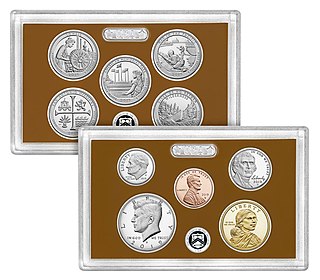
The United States Mint Proof Set, commonly known as the Proof Set in the United States, is a set of proof coins sold by the United States Mint. The proof set is popular with coin collectors as it is an affordable way to collect examples of United States coinage in proof condition.
The United States Uncirculated Coin Set, known as the Uncirculated Set or Mint Set in the United States, is an annual coin set sold by the United States Mint. The set is marketed towards coin collectors as a way to obtain circulation coins in mint condition.















